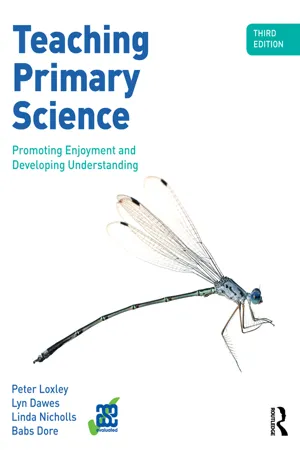
eBook - ePub
Teaching Primary Science
Promoting Enjoyment and Developing Understanding
- 432 pages
- English
- ePUB (mobile friendly)
- Available on iOS & Android
eBook - ePub
Teaching Primary Science
Promoting Enjoyment and Developing Understanding
About this book
This fully updated third edition brings science subject knowledge and pedagogy together to support, inform and inspire those training to teach primary science.
Written in a clear and accessible way, Teaching Primary Science provides comprehensive coverage of a wide range of science themes. With a brand new chapter on STEM education, additional guidance on where to find the best resources, and increased emphasis on assessment, story-telling and problem-solving, this book shows how science can offer children pleasure and intellectual satisfaction and help them to develop sound scientific minds.
Key features include:
- Ideas for practice exemplify how you can help children to acquire and use scientific knowledge to satisfy their curiosity about how the natural world works.
- Something to think about scenarios help to extend and develop your own understanding of key ideas.
- Examples of classroom situations, dialogues and stories help you see how theory is applied to practice and support you in reflecting on the best methods for teaching.
- Global Dimension sections offer starting points for discussion and research into how scientific ideas can be positively applied and used to evaluate the impact of human activity on the natural world.
- Talk Skills and Science Discussion sections enable you to develop children's scientific knowledge and verbal reasoning skills.
Frequently asked questions
Yes, you can cancel anytime from the Subscription tab in your account settings on the Perlego website. Your subscription will stay active until the end of your current billing period. Learn how to cancel your subscription.
No, books cannot be downloaded as external files, such as PDFs, for use outside of Perlego. However, you can download books within the Perlego app for offline reading on mobile or tablet. Learn more here.
Perlego offers two plans: Essential and Complete
- Essential is ideal for learners and professionals who enjoy exploring a wide range of subjects. Access the Essential Library with 800,000+ trusted titles and best-sellers across business, personal growth, and the humanities. Includes unlimited reading time and Standard Read Aloud voice.
- Complete: Perfect for advanced learners and researchers needing full, unrestricted access. Unlock 1.4M+ books across hundreds of subjects, including academic and specialized titles. The Complete Plan also includes advanced features like Premium Read Aloud and Research Assistant.
We are an online textbook subscription service, where you can get access to an entire online library for less than the price of a single book per month. With over 1 million books across 1000+ topics, we’ve got you covered! Learn more here.
Look out for the read-aloud symbol on your next book to see if you can listen to it. The read-aloud tool reads text aloud for you, highlighting the text as it is being read. You can pause it, speed it up and slow it down. Learn more here.
Yes! You can use the Perlego app on both iOS or Android devices to read anytime, anywhere — even offline. Perfect for commutes or when you’re on the go.
Please note we cannot support devices running on iOS 13 and Android 7 or earlier. Learn more about using the app.
Please note we cannot support devices running on iOS 13 and Android 7 or earlier. Learn more about using the app.
Yes, you can access Teaching Primary Science by Peter Loxley,Lyn Dawes,Linda Nicholls,Babs Dore in PDF and/or ePUB format, as well as other popular books in Education & Education General. We have over one million books available in our catalogue for you to explore.
Information

PART 1
THEORY AND PRACTICE

CHAPTER 1
THE PLEASURE OF FINDING THINGS OUT
You see? That’s why scientists persist in their investigations, why we struggle so desperately for every bit of knowledge, climb the steepest obstacles to the next fragment of understanding; […it is] part of the pleasure of finding things out.(Feynman, 1999)
During everyday experience, children observe and interpret for themselves the way the world works. As teachers, we need to find out what children have already experienced, imagined and concluded about scientific ideas. We have the challenge of helping them to come to a more scientific point of view. Children need access to established scientific information which is based on centuries of careful observation and research. At the same time, we must foster the curiosity which leads children to question theories and the creativity which enables them to generate new thinking. The intrinsic interest of science is in thinking through and resolving the puzzles which are the ways the world works.
Topics discussed in the chapter
● Children’s attitudes to science
● Insights into effective science teaching
● The pleasure of finding things out
● Storytelling and science teaching
Children’s attitudes to science
What children like about science
Children enjoy practical science; it is interesting to have a puzzle to solve, to set up your own investigation and find out something new. The resources we use in science are intrinsically fascinating – magnets, batteries and bulbs, snails and magnifiers. Excitingly, science happens outdoors or offers a chance to measure or observe things around the school. Such practical activity is motivating and engaging, especially if there is a strong collaborative element. Working with a classmate ensures that there is someone to share ideas, and means that disheartening personal failure is less likely. Children who learn a scientific way of thinking based on reasoning about evidence are learning a life skill. Through the experience of school science, many children acquire an enduring interest in how the world works. Their curiosity is fuelled when they find out enough to know that there are still questions to ask and things to investigate.
Problems with learning concepts
Science is not just about exploration but also about sharing the knowledge and understanding that people have accumulated over time. For children, the problem with science is having to ‘learn facts’. There is a lot to learn and it is easy to get things wrong. This includes new words or new uses of words because science, like many other activities, has its own technical vocabulary. A further difficulty is that some scientific explanations are counter-intuitive. Children’s everyday observations may lead them to hold firmly established ideas which turn out to be ‘wrong’ in terms of science. For example, a ball rolling along on grass will slowly come to a stop. If we think that the ball needs force to make it move, then it is reasonable to think that it stops because it has run out of force. A more scientific explanation would be that the ball eventually stops because the forces acting on it cause it to slow down. Children sometimes find science too abstract and separate from their everyday understanding. Force is an abstract idea; the concept of force is a strange notion for children as is the idea that humans are animals made up of little cells or that mass when affected by gravity becomes weight. Confusion arises because these scientific accounts do not map easily onto what children can see, feel and hear.
Something to think about
The Earth-centred model of the universe is an intuitive idea. When we watch the Sun rise in the east and set in the west, common sense tells us that it must be travelling around the Earth. The idea that this is an illusion caused by the spin of the Earth is counter-intuitive. Many scientific ideas are counterintuitive. What does this mean for the way we need to teach science? Is it feasible to expect children to discover scientific ideas for themselves?
In summary, children may see conceptual learning as hard work, dull and unoriginal. Although they like ‘doing experiments’, the children in Murphy and Beggs’ (2003) study reported disliking writing, learning facts and technical vocabulary. Learning facts for examinations can have a negative effect on attitudes; children tend to enjoy and value science more when they have opportunities to discuss and debate ideas and issues. Research has shown that there is the need to teach concepts in ways which relate to everyday life and appeal to children’s interests (Osborne et al., 2003; Simon, 2000; Cerini et al., 2003).
How can we make conceptual learning more rewarding?
In this book we offer a theory-based, practical approach to the teaching of science which we believe will help to overcome some of the difficulties children have with learning concepts. This approach involves teaching science as a collection of interrelated stories. Children are familiar with stories. They know that stories have a beginning, maybe with a puzzle or problem; a middle where events happen and may even become complicated or problematic; and a resolution, after which all becomes clear – although there may be other stories to be told subsequently. The process of science maps easily onto this narrative structure. The advantage of narrative is that it is a familiar and engaging form that can carry children along, helping them to generate a memorable understanding of science concepts, as ideas are framed in interesting and accessible contexts and explained in realistic terms.
A narrative approach to the teaching and learning of science can generate real enthusiasm for learning. Children can develop positive attitudes to the concepts they explore. A powerful mix of story and science can help children to develop a rewarding understanding of why and how things happen as they do.
Something to think about
What do you think the authors mean when they talk about presenting the scientific view as a narrative rather than a series of facts or definitions? What are the differences between the two approaches?
Insights into effective science teaching
Richard Feynman was one of the twentieth century’s most brilliant scientists, achieving the Nobel Prize for Physics in 1965. He had an infectious enthusiasm for science and loved sharing his ideas with anyone who wanted to listen. His ability to talk about science in accessible ways made him a popular and entertaining public speaker. In a lecture for teachers Feynman spoke about the teaching of scientific definitions (Feynman, 1999). He thought that, although children need to be taught certain scientific words and definitions, the learning of these words and definitions does not mean they are learning science. To illustrate the point, he described a picture of a wind-up toy dog he had seen in a science textbook with the question ‘What makes it move?’ written underneath. The answer the author of the book was looking for was that ‘Energy makes it move’. Feynman pointed out that this answer was meaningless for young people who are just learning about the concept of energy. He suggested that it would be equally meaningful to them to say that ‘God makes the toy move’ or ‘spirits make it move’. He then asked what the teacher would do if the children said that they did not think energy made the toy move. He wanted to know how the teacher would persuade them that the energy explanation is valid. Why not God? Why not spirits? Why is ‘energy’ the best explanation?
The point Feynman wanted to make was that ‘Energy makes things move’ is a definition which only makes sense to children after they understand the concept of energy. He suggested that children would learn more about how the toy worked by taking it apart to see how the spring is wound and how it releases to make the wheels go round. They could think about the effect of winding a spring and what has to happen to create a wound spring. They could learn how the Sun enables plants to grow and how eating plants provides people with the capacity to wind up the toy and make it move. For Feynman, the answer to the question ‘What makes it move?’ was that sunshine makes the dog move. And if children do not believe this, then teachers and children have a lot of interesting things to talk about.
Beware of mystic formulae
In his lecture Feynman used the term ‘mystic formulae’ to describe some of the explanations used in science books to answer questions. In particular, he focused on the concept of friction and criticised the practice of using mystic formulae such as ‘The soles of shoes wear out because of friction’ as scientific explanations. In his own words: ‘Shoe leather wears out because it rubs against the sidewalk and the little notches and bumps on the sidewalk grab pieces and pull them off. To simply say it is because of friction is sad, because it’s not science’ (Feynman, 1999: 180).
Fey...
Table of contents
- Cover
- Half Title
- Title Page
- Copyright Page
- Table of Contents
- List of figures and tables
- Guided tour
- Preface
- Acknowledgements
- Part 1 Theory and practice
- Part 2 Subject knowledge and ideas for practice
- Appendix A: Information and teaching resources
- Appendix B: Links to the companion book
- References
- Glossary
- Index